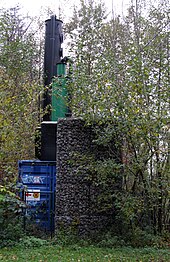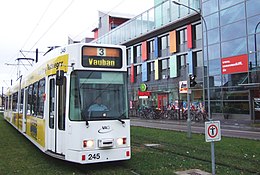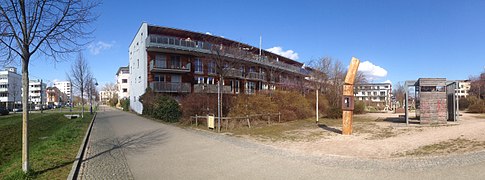Vauban (Freiburg im Breisgau)
|
Quartier Vauban Freiburg im Breisgau |
|
|---|---|
| City district Freiburg (FR) Baden-Wuerttemberg , Germany |
|

|
|
| Basic data | |
| District of Freiburg | |
| District number: | 68 (District: 680) |
| Geographic location : | 47 ° 58 '33 " N , 7 ° 49' 29" E |
| Height : | 255 m above sea level NN |
| Area : | 0.41 km² |
| Residents : | 5,602 (December 31, 2017) |
| Population density : | 13,663 inhabitants per km² |
| Proportion of foreigners : | 14% |
| Postal code : | 79100 |
| Area code : | 0761 |
The Vauban [ vobɑː ] is the latest, partly car-free district in the south of the city Freiburg with 5,602 inhabitants (December 31, 2017). When planning the new district in the 1990s, the forecast was 6000 inhabitants and 600 jobs. Until December 31, 2007 it belonged mainly to the Freiburg district of St.Georgen-Süd (622) ; the plus energy houses of the solar settlement east of Merzhauser Strasse were part of the Unterwiehre Süd district (424) . Since January 1, 2008, the district has been run as a separate - and with 41 hectares, the smallest - Freiburg district with the number 680.
In the south the quarter borders on the independent municipality of Merzhausen .
history
The new district was built on the site of the former Wehrmacht barracks, which had been built from 1937 in Gewann Feldmatten on the area of the winegrowing village of St. Georgen , which was incorporated into Freiburg in 1938. The barracks was named after the Freikorps activist Albert Leo Schlageter , a martyr figure of the National Socialist movement.
With the beginning of the French occupation at the end of the Second World War , the French army took over the area for further use as barracks. They named it after the French fortress builder Sébastien Le Prestre de Vauban , who rebuilt and expanded Freiburg at the time of the French occupation at the end of the 17th century (1679–1697) into a star-shaped fortress typical of the period before moving to France in Neuf-Brisach 1699–1703 in the open field the ideal type of such a fortress could be realized. After the withdrawal of the French military contingent on August 15, 1992 as a result of German reunification and the provisions of the two-plus-four treaty , the name Vaubans was retained for the new residential area.
Until the decision about the future of the district was made, there were interim solutions for the conversion of the barracks buildings. Bosnian civil war refugees were housed, emergency accommodation for homeless citizens and the assembly point for asylum seekers were set up. The deaf center also leased a house and the Freiburg riders used the French stables.
In 1994 an initiative called KTS arose in an occupied building in the empty barracks . Due to the land ownership there were delays in the renovation and re-planning of the site. On December 22nd, 1994 the Forum Vauban was founded as an association with starting capital of DM 98,000.
The construction of the first new houses began after most of the barracks buildings had been demolished in April 1998. On July 1, 2006, 4,100 inhabitants were counted, at the end of 2008 almost 5,000.
The concept of the district was presented in the Urban Best Practices section of the Expo 2010 at the exhibition stand of the city of Freiburg.
How the entrance area should be designed was the subject of a long-standing dispute between the district association and the Freiburg city planning department. In April 2010 it was announced that the area, which at the time was still occupied by a collective of wagons, should be built on with two four to five-story buildings by the beginning of 2012 at the latest. In 2011, the car collective Kommando Rhino disbanded or the site was cleared in August 2011 and construction work began. In 2013, the M1 townhouse by Berlin-based Barkow Leibinger Architects was completed, which includes the Green City Hotel Vauban as the first integrative hotel in Freiburg in one part and an upscale residential and commercial building in the other .
Development

All buildings were built in accordance with at least the Freiburg low-energy standard, with the approximately 100 units in the solar settlement generating more energy over the year than they consume themselves. There are a few passive houses , including the first apartment building in passive house construction in Germany. Some of the houses are equipped with vacuum toilets and Ecosan wastewater technology. The population density of 12,500 inhabitants / km² is relatively high and roughly corresponds to the density in the inner city districts of many major German cities.
The area borders directly on a nature-protected stream with old trees, which is a biotope for a large number of rare animals. Because of the earlier military use of the area, the groundwater is particularly contaminated with hydrocarbons. It is circulated and exchanged in its own facility. It should be perfect again in 2026.
At the beginning of 2017, the last vacant lot at the corner of Wiesentalstrasse and Merzhauser Strasse was closed with the V8 .
Residents
A large proportion of the population in the district are families who, organized in building groups, have built apartments together inexpensively and often with a lot of personal contribution. GENOVA is an important cooperative building and housing project. Around a third of the population is under 18 years of age, and the proportion of children is very high. This means that the Quartier Vauban, along with the second large, new Rieselfeld district, is one of the most child-rich districts in Freiburg and is often referred to as the currently largest in Germany. In addition, there are a large number of rooms for students of the Freiburg Student Union in converted and expanded former barracks buildings in the district .
Infrastructure
primary school
Due to the high number of children, the Karoline Kaspar primary school had to be expanded soon after it opened.
shops
The quarter has three bakery shops, two children's and youth clothing stores, a bookstore, an ice cream parlor, two health food stores, a supermarket, a drugstore, a florist, a bicycle shop with a workshop, a computer shop, two carpenters, a shoemaker and a pharmacy. On Wednesday afternoons there is a market on Alfred-Döblin-Platz.
fire Department
Vauban citizens can become volunteer firefighters in the Lower City Department of the Freiburg Fire Brigade . This department was stationed in the former barracks in the middle of Vauban for many years, but is now located in the renovated and expanded Hauptwache in Eschholzstraße.
Green spaces
When creating the district, various garden architects, in cooperation with the local population, created three green belts with a total area of 15 hectares in a north-south direction. You come across the Dorfbach, which flows from Merzhausen through St. Georgen and includes games for children and young people as well as a self-managed bakery. The cool slope winds from Schönberg ensure good ventilation of the district. Some of the more than 60 years old trees such as linden, maple, plane and beech are still preserved. B. on Vaubanallee. There is a newly built willow dome near the end of the tram. In 2013 the Grünspangen in Vauban was honored by the Association of German Landscape Architects among a hundred special locations.
In 2004, a memorial for the Hitler assassin was erected in a green brace near Georg-Elser- Strasse, which - as the poplar wood had rotted - had to be dismantled in 2013. In 2015 it was replaced by a new stele made of robinia wood.
Information boards
In November 2014, three information boards were set up on the district at Paula-Modersohn-Platz, Alfred-Döblin-Platz and the tram terminus at Innsbrucker Straße.
Citizen participation
A key feature of the Vauban project is the extended public participation by the Forum Vauban association and the association's attempt to design the district as a sustainable model district . The association, which was founded in 1994 on the initiative of Matthias-Martin Lübke and Andre Heuss, succeeded in working with individual municipal councils and partly against the mayor and responsible urban planners of the city administration to incorporate alternative ecological impulses into the planning of the district. So a new traffic concept was developed (car / parking space free) and implemented. There is a modern local heating system with a wood chip- fired block- type thermal power station . In addition, a particularly large number of passive houses were built in the district.
Several alternative projects (e.g. the self-managed independent settlement initiative SUSI , which created living space for students and social housing in an alternative housing concept) have converted old barracks buildings, among other things, at low cost. A self-administered district center, House 037, was created in one of the barracks buildings that have been preserved . In the spring of 2005, some former barracks were occupied because they were about to be demolished.
Traffic concept
An important concern of the Forum Vauban was to create a sustainable quarter, especially with regard to traffic. The quarter should be connected to the tram network of Freiburg as soon as possible , which has been implemented since April 2006. The light rail line 3 of the VAG opens up the area with three stops. The first stop at Paula-Modersohn-Platz is a connection to the SBG bus line 7208 to Hexental or to the main train station. At the terminus at Innsbrucker Straße there is a connection to bus line 11 to St. Georgen.
The households or residents have the choice between car-free and parking space-free living. In two parking garages on the outskirts of the district, residents of the district, if they are car owners, have to purchase a parking space (for around 18,000 euros). In the district, in the residential streets, which are all traffic-calmed areas, and in front of the house, the car used may only be used for a short time, e.g. B. for loading and unloading can be parked. Otherwise it is to be parked on the purchased parking space. Anyone who does not have their own car or uses car sharing (there are around 400 car sharing users in the neighborhood and currently 15 car sharing cars) has to buy a portion of a reserve area for around 3500 euros in order to later, if a car is purchased, one there To be able to acquire parking space. This is registered as a land charge. A car free association , founded by the initiators of the traffic concept, monitors compliance with the rules for car-free living.
By dispensing with parking spaces in the quarter, most of the public residential streets can be used for child-friendly leisure activities and, together with the numerous green spaces, offer a special urban quality of life. Since almost all parking spaces in the district garages are occupied at the beginning of 2018 and in order not to build on the reserve area, which is used as a green area with urban gardening and willow dome, a pool of rented parking spaces is to be set up.
Critics of the traffic concept criticize the lack of parking spaces for visitors, which only existed temporarily because residents parked their cars in the parking spaces provided for visitors and the city of Freiburg largely failed to carry out an inspection by the municipal enforcement service until autumn 2006. Since regular checks have been carried out, there is sufficient parking space for visitors during the day. The car-free association suspects that around 10-15 percent of the neighborhood's adult residents try to circumvent the car-free regulations by registering their own cars with other people who do not live in the neighborhood or in some other way. The municipality of Merzhausen therefore introduced parking permits for its citizens in the areas bordering the Vauban in 2018.
Overall, it can be said that the traffic concept works surprisingly well despite many concerns. At least the initiator and the person responsible for the implementation, Matthias-Martin Lübke, is satisfied with the acceptance by the residents. "It will and is already evident (not only in view of the large number of visitors from all over the world) that Vauban is exemplary for urban planning in the age of the emerging climate catastrophe when it comes to traffic planning," says Lübke.
District drainage
For part of the Vauban site, an innovative overall concept of surface drainage in a modified separation system with elements of near-natural rainwater management was developed as part of the development plan . This consists of decentralized rainwater management of public and private areas to reduce surface runoff ( green roofs , permeable surface paving, green areas, trees, rainwater harvesting) in combination with a central trough-trench system (MRS) with free overflow into the village stream ( receiving water ) for retention, Infiltration and discharge of surface runoff.
Studies by the University of Freiburg showed a high degree of effectiveness: the decentralized measures in the area (green roofs, permeable surface paving, green areas, trees) combined with a downstream infiltration via a trough-trench system reduced the area runoff by 87% (2011) and 66% (2012). The gravel-filled or green roof structures were able to reduce the roof drainage by 40 to 70% and at the same time delayed the flow peaks. Both the troughs, which are rich in species with wild flowers and wild herbs, and the green roofs provide a habitat for insects and contribute to the quality of stay.
Photo gallery
literature
- Hannelore Pfeifer: Vauban - waiting loop. Photographs. Syntagma, Freiburg 2008, ISBN 978-3-940548-05-4 .
- Andreas Kuntz (Ed.): ... they released the ecos! Stories from Vauban. Freiburg 2006, ISBN 3-00-016965-2 .
- Bobby Glatz: The houses for those who live in them: a tenant self-help project in the new model district Quartier Vauban in Freiburg. In: Forum Wissenschaft 2001, pp. 26–30.
- Parking garage with sun deck: Vauban solar garage in Freiburg. In: Intelligent Architecture. 2000, pp. 60-63.
- Christoph Gunßer: Urban ecology: Quartier Vauban in Freiburg. In: Deutsche Bauzeitung. 134, 2000, pp. 80-87.
- Bernhard Thill: Vauban - a new district is emerging. In: Freiburg Almanac. 50, 1999, pp. 41-48.
Web links
Individual evidence
- ^ History - freiburg-vauban.de. Retrieved December 26, 2018 .
- ↑ Reinhard Huschke: The model city in Telepolis from March 20, 2010
- ↑ Quartier Vauban ( Memento of the original from June 19, 2010 in the Internet Archive ) Info: The archive link was inserted automatically and has not yet been checked. Please check the original and archive link according to the instructions and then remove this notice. at expo2010.freiburg.de, accessed on March 20, 2010
- ^ Badische-Zeitung.de: “Berlin architects design a new entrance for Vauban”, April 17, 2010 , accessed on May 13, 2010.
- ↑ Dispute over eviction: Wagenburg Kommando Rhino has disbanded . In: Badische Zeitung , November 30, 2011. Retrieved March 12, 2012
- ↑ My friend, the tree in FAZ of October 21, 2013, page 30
- ↑ Climbing plants included - badische-zeitung.de. Retrieved June 19, 2013 .
- ↑ Andreas Delleske: passive house "Living & Working" Walter-Gropius-Straße 22, 2005, accessed 4 February 2010 .
- ↑ Simone Lutz: 25 years of eco: In Vauban everything is in the green. Badische Zeitung, January 16, 2017, accessed on December 26, 2018 .
- ↑ Freiburg Fire Department Department 02 Lower Town. Retrieved February 28, 2014 .
- ^ Garden and Civil Engineering Office, Martin Leser
- ^ Residential area Vauban - Projects • Landscape architecture today. Retrieved August 31, 2013 .
- ↑ Garden Worlds 2013 - Quartier Vauban - July 17, 2013 - Bund Deutscher Landschaftsarchitekten bdla. Retrieved February 8, 2016 .
- ↑ New stele on the Grünspange: In Vauban there is again a memorial for the Hitler assassin Georg Elser - badische-zeitung.de. Retrieved April 12, 2015 .
- ^ Freiburg Süd: The flagship district at a glance - badische-zeitung.de. Retrieved November 6, 2014 .
- ^ Jelka Louisa Beule: Car-free association wants to save green space - Freiburg Süd - Badische Zeitung. Badische Zeitung, January 12, 2018, accessed on January 12, 2018 .
- ↑ Nikola Vogt: Parking permits have defused the problem. Badische Zeitung, October 18, 2018, accessed on December 26, 2018 .
- ↑ Nicole Jackisch, Thomas Brendt, Markus Weiler, Jörg Lange (2013): Evaluation of rainwater management in the Vaubangelände - with special consideration of green roofs and vegetation. Final report of the Institute for Geo- and Environmental Sciences / Professorship for Hydrology at the University of Freiburg (project number: 2009-09). 96 pp.








